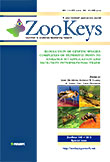Ver ítem
- xmlui.general.dspace_homeCentros e Institutos de InvestigaciónCICVyA. Centro de Investigación en Ciencias Veterinarias y AgronómicasInstituto de GenéticaArtículos científicosxmlui.ArtifactBrowser.ItemViewer.trail
- Inicio
- Centros e Institutos de Investigación
- CICVyA. Centro de Investigación en Ciencias Veterinarias y Agronómicas
- Instituto de Genética
- Artículos científicos
- Ver ítem
Evaluating mating compatibility within fruit fly cryptic species complexes and the potential role of sex pheromones in pre-mating isolation
Resumen
The study of sexual behavior and the identification of the signals involved in mate recognition between con-specifics are key components that can shed some light, as part of an integrative taxonomic approach, in delimitating species within species complexes. In the Tephritidae family several species complexes have received particular attention as they include important agricultural pests such as the Ceratitis fasciventris (Bezzi), Ceratitis anonae
[ver mas...]
The study of sexual behavior and the identification of the signals involved in mate recognition between con-specifics are key components that can shed some light, as part of an integrative taxonomic approach, in delimitating species within species complexes. In the Tephritidae family several species complexes have received particular attention as they include important agricultural pests such as the Ceratitis fasciventris (Bezzi), Ceratitis anonae (Graham) and Ceratitis rosa Karsch (FAR) complex, the Bactrocera dorsalis (Hendel) complex and the Anastrepha fraterculus (Wiedemann) complex. Here the value and usefulness of a methodology that uses walk-in field cages with host trees to assess, under semi-natural conditions, mating compatibility within these complexes is reviewed, and the same methodology to study the role of chemical communication in pre-mating isolation among Anastrepha fraterculus populations is used. Results showed that under the same experimental conditions it was possible to distinguish an entire range of different outcomes: from full mating compatibility among some populations to complete assortative mating among others. The effectiveness of the methodology in contributing to defining species limits was shown in two species complexes: Anastrepha fraterculus and Bactrocera dorsalis, and in the case of the latter the synonymization of several established species was published. We conclude that walk-in field cages constitute a powerful tool to measure mating compatibility, which is also useful to determine the role of chemical signals in species recognition. Overall, this experimental approach provides a good source of information about reproductive boundaries to delimit species. However, it needs to be applied as part of an integrative taxonomic approach that simultaneously assesses cytogenetic, molecular, physiological and morphological traits in order to reach more robust species delimitations.
[Cerrar]

Autor
Juárez, María Laura;
Devescovi, Francisco;
Břízová, Radka;
Bachmann, Guillermo Enrique;
Segura, Diego Fernando;
Kalinová, Blanka;
Fernandez, Patricia;
Ruiz, María Josefina;
Yang, Jianquan;
Teal, Peter E. A.;
Caceres, Carlos;
Vreysen, Marc J. B.;
Hendrichs, Jorge;
Vera, María Teresa;
Fuente
ZooKeys 540 : 125-155 (Noviembre 2015)
Fecha
2015-11
Editorial
Pensoft Publishers
ISSN
1313-2970
Formato
pdf
Tipo de documento
artículo
Palabras Claves
Derechos de acceso
Abierto
 Excepto donde se diga explicitamente, este item se publica bajo la siguiente descripción: Creative Commons Attribution-NonCommercial-ShareAlike 2.5 Unported (CC BY-NC-SA 2.5)
Excepto donde se diga explicitamente, este item se publica bajo la siguiente descripción: Creative Commons Attribution-NonCommercial-ShareAlike 2.5 Unported (CC BY-NC-SA 2.5)


